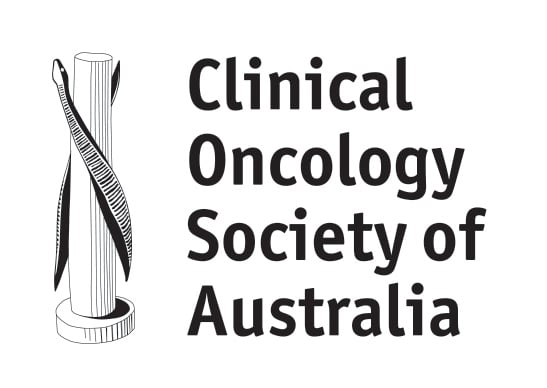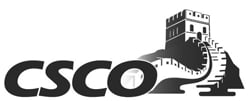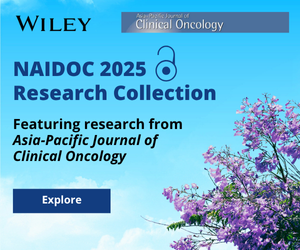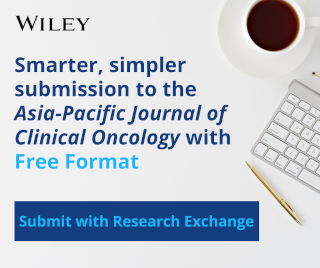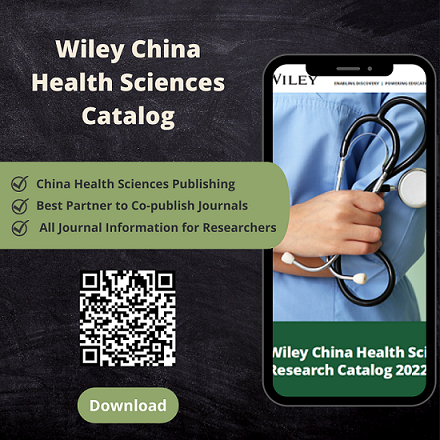Author Guidelines
Sections
1. SUBMISSION
2. AIMS AND SCOPE
3. MANUSCRIPT CATEGORIES AND REQUIREMENTS
4. PREPARING THE SUBMISSION
5. EDITORIAL POLICIES AND ETHICAL CONSIDERATIONS
6. AUTHOR LICENSING
7. PUBLICATION PROCESS AFTER ACCEPTANCE
8. POST PUBLICATION
9. EDITORIAL OFFICE CONTACT DETAILS
Authors should kindly note that submission implies (i) that the content has not been published previously, in any language, in whole or in part, except as a brief abstract in the proceedings of a scientific meeting or symposium; and (ii) that the manuscript is not currently under consideration for publication elsewhere.
Asia-Pacific Journal of Clinical Oncology now offers Free Format submission for a simplified and streamlined submission process allowing researchers to submit their manuscript in their preferred formatting style at original submission. See details in Section 4. PREPARING THE SUBMISSION.
Once you have prepared your submission in accordance with the Guidelines, New submissions should be made via the Research Exchange submission portal https://submission.wiley.com/journal/ajco. Should your manuscript proceed to the revision stage, you will be directed to make your revisions via the same submission portal. You may check the status of your submission at anytime by logging on to submission.wiley.com and clicking the “My Submissions” button. For technical help with the submission system, please review our FAQs or contact [email protected].
The submission system will prompt you to use an ORCiD (a unique author identifier) to help distinguish your work from that of other researchers. Click here to find out more.
Cover letter. A cover letter should be included in the ‘Cover Letter Field’ of the Research Exchange submission portal. The text can be entered directly into the field or uploaded as a file. The covering letter must contain i) An acknowledgment that all authors have contributed significantly, ii) A statement that all authors are in agreement with the content of the manuscript, iii) An author's declaration of any financial support or relationships that may pose conflict of interest (for more detail refer to the section ‘Conflict of Interest Declaration’ below). Please note that the cover letter does not require a detailed or lengthy description of the content or structure of the manuscript itself.
Data Protection
By submitting a manuscript to or reviewing for this publication, your name, email address, and affiliation, and other contact details the publication might require, will be used for the regular operations of the publication, including, when necessary, sharing with the publisher (Wiley) and partners for production and publication. The publication and the publisher recognize the importance of protecting the personal information collected from users in the operation of these services and have practices in place to ensure that steps are taken to maintain the security, integrity, and privacy of the personal data collected and processed. You can learn more at https://authorservices.wiley.com/statements/data-protection-policy.html
We look forward to your submission.
Asia-Pacific Journal of Clinical Oncology is a multidisciplinary journal of oncology that aims to be a forum for facilitating collaboration and exchanging information on what is happening in different countries of the Asia-Pacific region in relation to cancer treatment and care. The journal is ideally positioned to receive publications that deal with diversity in cancer behavior, management and outcome related to ethnic, cultural, economic and other differences between populations. In addition to original articles, the Journal publishes reviews, editorials, letters to the Editor and short communications. Case reports are generally not considered for publication, only exceptional papers in which Editors find extraordinary oncological value may be considered for review. The journal encourages clinical studies, particularly prospectively designed clinical trials.
3. MANUSCRIPT CATEGORIES AND REQUIREMENTS
Contributions may take the form of Original Articles, Review Articles or Letters to the Editor. Case Reports will only be considered if they are of exceptional scientific or educational interest.
i. Original Articles
Word limit: 3,500 words maximum excluding abstract and references
Abstract: 250 words maximum and must include subheadings (Aim, Methods, Results, Conclusion)
References: up to 50
Figures/Tables: up to 5
Description: Full-length reports of current research in either basic or clinical science
ii. Review Articles
Word limit: 5,000 words
Abstract: unstructured, preferably less than 200 words
References: up to 75
Figures/Tables: 3-7
Description: Reviews are comprehensive analyses of specific topics. If a review longer than 5,000 words is required to discuss the topic in depth, the author should submit two reviews, each discussing a different aspect of the topic.
iii. Letter to the Editor
Word limit: 500 words maximum
Abstract: not required
References: 5 maximum
Figures/Tables: 1 in total (maximum)
Description: Letters may be submitted to the Editor on any topic of discussion; substantial clinical observations as well as letters discussing papers published in recent issues. Letters to the Editor are not subjected to peer-review, but publication is at the discretion of the Editor or Publisher. Submissions may be edited for length, grammatical correctness and journal style. Authors will be asked to approve the editorial changes that alter the substance or tone of a letter or response. Letters that offer perspective on content already published in APJCO can use an arbitrary title, but a Response from Authors must cite the title of the first Letter: e.g. Response to [title of Letter]. This ensures that readers can track the line of discussion.
iv. Case Report
Word limit: 1,500 words
Abstract: unstructured, preferably less than 200 words
References: up to 10
Figures/Tables: 1 in total (maximum)
Description: Case Reports are generally not considered for publication, only exceptional papers in which the Editors find extraordinary oncological value may be considered for review.
Free Format submission
Asia-Pacific Journal of Clinical Oncology now offers Free Format submission for a simplified and streamlined submission process.
Before you submit, you will need:
- Your manuscript: manuscripts can be uploaded either as a single document (containing the main text, tables and figures), or with figures and tables provided as separate files. Should your manuscript reach revision stage, figures and tables must be provided as separate files. The main manuscript file should be submitted in Microsoft Word (.doc or .docx) format.
Your main document file should include:
· A short informative title containing the major key words. The title should not contain abbreviations;
· The full names of the authors with institutional affiliations where the work was conducted, with a footnote for the author’s present address if different from where the work was conducted;
· Acknowledgments;
· Abstract structured (intro/methods/results/conclusion) or unstructured
· Five keywords;
· Practitioner Points (optional) Authors will need to provide no more than 3 ‘key points’, written with the practitioner in mind, that summarize the key messages of their paper to be published with their article.
· Main body: formatted as introduction, materials & methods, results, discussion, conclusion
· References;
· Tables (each table complete with title and footnotes);
· Figures: Figure legends must be added beneath each individual image during upload AND as a complete list in the text.
All required sections should be contained in your manuscript, including abstract, introduction, methods, results, and conclusions. Figures and tables should have legends. References may be submitted in any style or format, as long as it is consistent throughout the manuscript. If the manuscript, figures or tables are difficult for you to read, they will also be difficult for the editors and reviewers. If your manuscript is difficult to read, the editorial office may send it back to you for revision. -
Graphical abstracts
Asia Pacific Journal of Clinical Oncology publishes graphical abstracts for each article, displayed online in graphical form with a brief abstract (in addition to the <250 word abstract above).
The online table of contents will display a schematic figure to convey the core message of your paper, alongside a short abstract highlighting the major findings of the paper. Authors must submit a new and stand-alone image, not already included in the paper. Your graphical abstract should be simple, colourful and contain minimal text to attract additional readers. Your short abstract should consist of 2-3 sentences (max 500 characters with spaces) summarising the key findings presented in the paper. Graphical abstract entries should be submitted to Research Exchange separatly and uploaded as ‘Graphical Abstract Image’ and 'Graphical Abstract Text' during the initial manuscript submission process. The image should be supplied as a tif or a pdf and fit within the dimensions of 50mm x 60mm, and be fully legible at this size.
- The title page of the manuscript, including statements relating to our ethics and integrity policies:
- data availability statement
- funding statement
- conflict of interest disclosure
- ethics approval statement
- patient consent statement
- permission to reproduce material from other sources
- Your co-author details, including affiliation and email address. (Why is this important? We need to keep all co-authors informed of the outcome of the peer review process.)
- An ORCID ID, freely available at https://orcid.org. (Why is this important? Your article, if accepted and published, will be attached to your ORCID profile. Institutions and funders are increasingly requiring authors to have ORCID IDs.)
To submit, login at https://submission.wiley.com/journal/ajco and create a new submission. Follow the submission steps as required and submit the manuscript.
If you are invited to revise your manuscript after peer review, the journal will also request the revised manuscript to be formatted according to journal requirements as described below.
Manuscript Style
Manuscripts should follow the style of the Vancouver agreement detailed in the International Committee of Medical Journal Editors’ revised ‘Uniform Requirements for Manuscripts Submitted to Biomedical Journals: Writing and Editing for Biomedical Publication’, as presented at http://www.ICMJE.org/.
Reports of systematic literature reviews and meta-analyses should comply with The Preferred Reporting Items of Systematic reviews Meta-Analyses (PRISMA) statement, which is available at http://www.prisma-statement.org
Spelling: The journal uses US spelling and authors should therefore follow the latest edition of the Merriam–Webster’s Collegiate Dictionary.
Units: All measurements must be given in SI or SI-derived units.
Percentage and fractions: Where the denominator is 100, whole number should be used in tables and texts.
Abbreviations: Abbreviations should be used sparingly. Initially use the word in full, followed by the abbreviation in parentheses. Thereafter use the abbreviation only.
Trade names: Drugs should be referred to by their generic names. If proprietary drugs have been used in the study, refer to these by their generic name, mentioning the proprietary name, and the name of the manufacturer, in parentheses.
Parts of the manuscript
Manuscripts should be presented in the following order: (i) title page, (ii) abstract and keywords, (iii) text, (iv) acknowledgments, (v) references, (vi) appendices, (vii) tables (each table complete with title and footnotes), (viii) figure legends and (ix) figures. The title page and figures (if consisting of images) should be uploaded as separate files. Footnotes to the text are not allowed and any such material should be incorporated into the text as parenthetical matter.
Title page
The title page should contain:
(i) a short informative title that contains the major key words. The title should not contain abbreviations (see Wiley's best practice SEO tips);
(ii) the full names of the authors;
(iii) the author's institutional affiliations at which the work was carried out;
(iv) a short running title (less than 40 characters);
(iv) the full postal and email address, plus telephone number, of the author to whom correspondence about the manuscript should be sent;
(v) acknowledgements.
The present address of any author, if different from that where the work was carried out, should be supplied in a footnote.
Abstract and key words
All original articles must have a brief structured abstract that states in 250 words or fewer the purpose, basic procedures, main findings and principal conclusions of the study. Divide the abstract with the headings: Aim, Methods, Results, Conclusion. The abstract should not contain abbreviations or references.
Five key words, for the purposes of indexing, should be supplied below the abstract, in alphabetical order, and should be taken from those recommended by the US National Library of Medicine's Medical Subject Headings (MeSH) browser list at http://www.nlm.nih.gov/mesh/meshhome.html.
Video Abstracts: A video abstract can be a quick way to make the message of your research accessible to a much larger audience. Wiley and its partner Research Square offer a service of professionally produced video abstracts, available to authors of articles accepted in this journal. You can learn more about it, and purchase one for your article, at http://www.wileyauthors.com/videoabstracts . If you have any questions, please direct them to [email protected] .
Acknowledgments
The source of financial grants and other funding must be acknowledged, including a frank declaration of the authors’ industrial links and affiliations. The contribution of colleagues or institutions should also be acknowledged. Personal thanks and thanks to anonymous reviewers are not appropriate.
Conflicts of Interest (CoI)
Authors will be asked to provide a conflict of interest statement during the submission process. Each article must include a statement regarding CoI, regardless of whether or not a CoI exists. See ‘Conflict of Interest’ section in Editorial Policies and Ethical Considerations for details on what to include in this section. Authors should ensure they liaise with all co-authors to confirm agreement with the final statement.
References
The Vancouver system of referencing should be used (examples are given below). In the text, references should be cited using superscript Arabic numerals in the order in which they appear. If cited in tables or figure legends, number according to the first identification of the table or figure in the text. In the reference list, cite the names of all authors when there are six or fewer; when seven or more, list the first three followed by et al. Do not use ibid. or op cit. Reference to unpublished data and personal communications should not appear in the list but should be cited in the text only (e.g. (Dr Robert Smith, pers. comm., 2005). All citations mentioned in the text, tables or figures must be listed in the reference list. Authors are responsible for the accuracy of the references.
Journal article
1 Vega KJ, Pina I, Krevsky B. Heart transplantation is associated with an increased risk for pancreatobiliary disease. Ann Intern Med 1996; 124: 981-3.
Online journal article not yet published in an issue. An online article that has not yet been published in an issue (therefore has no volume, issue or page numbers) can be cited by its Digital Object Identifier (DOI). The DOI will remain valid and allow an article to be tracked even after its allocation to an issue.
2 Inoue S, Ichikawa T, Kurozumi K et al. Novel animal glioma models that separately exhibit two different invasive and angiogenic phenotypes of human glioblastomas. World Neurosurg 2012. doi: 10.1016/j.wneu.2011.09.005
Book
3 Fujita M, Krugman P, Venables AJ. The Spatial Economy: Cities, Regions, and International Trade. MIT Press, Cambridge MA 2001.
Chapter in a book
4 Phillips SJ, Whisnant JP. Hypertension and stroke. In: Laragh JH, Brenner BM (eds). Hypertension: Pathophysiology, Diagnosis, and Management, 2nd edn. Raven Press, New York 1995; 465–78.
Tables
Tables should be self-contained and complement, but not duplicate, information contained in the text. Number tables consecutively in the text in Arabic numerals. Type tables on a separate sheet with the legend above. Legends should be concise but comprehensive – the table, legend and footnotes must be understandable without reference to the text. Column headings should be brief, with units of measurement in parentheses; all abbreviations must be defined in footnotes. Footnote symbols: †, ‡, §, , should be used (in that order) and *, **, *** should be reserved for P-values. Statistical measures such as SD or SEM should be identified in the heading.
Figure legends
Type figure legends on a separate page. Legends should be concise but comprehensive – the figure and its legend must be understandable without reference to the text. Include definitions of any symbols used and define/explain all abbreviations and units of measurement.
Figures
Although we encourage authors to send us the highest-quality figures possible, for peer-review purposes we are happy to accept a wide variety of formats, sizes, and resolutions.
Click here for the basic figure requirements for figures submitted with manuscripts for initial peer review, as well as the more detailed post-acceptance figure requirements.
Colour figures: Figures submitted in colour may be reproduced in colour online free of charge. Please note, however, that it is preferable that line figures (e.g. graphs and charts) are supplied in black and white so that they are legible if printed by a reader in black and white.
Appendices
Appendices will be published after the references. For submission they should be supplied as separate files but referred to in the text.
Supporting Information
Supporting information is information that is not essential to the article but that provides greater depth and background. It is hosted online and appears without editing or typesetting. It may include tables, figures, videos, datasets, etc. Click here for Wiley’s FAQs on supporting information.
Note, if data, scripts or other artefacts used to generate the analyses presented in the paper are available via a publicly available data repository, authors should include a reference to the location of the material within their paper.
Associate your Research Exchange account with your ORCID iD
ORCID iD is a unique and persistent identifier that distinguishes you from every other researcher and connects you and your research activities. We require you to register for an ORCID iD and then associate it with your Research Exchange account.
Wiley Author Resources
Wiley has a range of resources for authors preparing manuscripts for submission available here. In particular, authors may benefit from referring to Wiley’s best practice tips on Writing for Search Engine Optimization.
Article Preparation Support
Wiley Editing Services offers expert help with English Language Editing, as well as translation, manuscript formatting, figure illustration, figure formatting, and graphical abstract design – so you can submit your manuscript with confidence.
Also, check out our resources for Preparing Your Article for general guidance about writing and preparing your manuscript.
5. EDITORIAL POLICIES AND ETHICAL CONSIDERATIONS
Editorial Review and Acceptance
The acceptance criteria for all papers are the quality and originality of the research and its significance to our readership. Except where otherwise stated, manuscripts are peer reviewed by two anonymous reviewers and the Editor. Final acceptance or rejection rests with the Editorial Board, who reserves the right to refuse any material for publication.
Manuscripts should be in a clear, concise, direct style. Where contributions are judged as acceptable for publication on the basis of scientific content, the Editor or the Publisher reserve the right to modify typescripts to eliminate ambiguity and repetition and improve communication between author and reader. If extensive alterations are required, the manuscript will be returned to the author for revision.
Data Sharing and Data Accessibility
The journal encourages authors to share the data and other artefacts supporting the results in the paper by archiving it in an appropriate public repository. Authors should include a data accessibility statement, including a link to the repository they have used, in order that this statement can be published alongside their paper. Review Wiley’s Data Sharing policy where you will be able to see and select the data availability statement that is right for your submission.
Data Citation
Please review Wiley’s Data Citation policy.
Human Studies
Manuscripts must contain a statement to the effect that all human studies have been reviewed by the appropriate ethics committee and have therefore been performed in accordance with the ethical standards laid down in an appropriate version of the Declaration of Helsinki (as revised in Brazil 2013), available at http://www.wma.net/en/30publications/10policies/b3/index.html. It should also state clearly in the text that all persons gave their informed consent prior to their inclusion in the study. Details that might disclose the identity of the subjects under the study should be omitted.
Use of Animals in Research
Reports of animal experiments must state that the ‘Principles of Laboratory Animal Care’ (NIH Publication Vol 25, No. 28 revised 1996; http://grants.nih.gov/grants/guide/notice-files/not96-208.html ) were followed, as well as specific national laws (e.g. the current version of the German Law on the Protection of Animals) where applicable.
Research Reporting Guidelines
Accurate and complete reporting enables readers to fully appraise research, replicate it, and use it. We encourage authors to adhere to the following research reporting standards.
Prospective Clinical Trial Registration
The journal requires that the clinical trials submitted for its consideration are registered in a publicly accessible database. Authors should include the name of the trial register and their clinical trial registration number in the ‘Acknowledgements’ section of their manuscript. If you wish the editor[s] to consider an unregistered trial, please explain briefly why the trial has not been registered.
The journal requires that all authors disclose any potential sources of conflict of interest. Any interest or relationship, financial or otherwise that might be perceived as influencing an author's objectivity is considered a potential source of conflict of interest. These must be disclosed when directly relevant or directly related to the work that the authors describe in their manuscript. Potential sources of conflict of interest include, but are not limited to, any financial arrangements they have with a company whose product figures prominently in the submitted manuscript or with a company making a competing product, patent or stock ownership, membership of a company board of directors, membership of an advisory board or committee for a company, and consultancy for or receipt of speaker's fees from a company. The existence of a conflict of interest does not preclude publication. If the authors have no conflict of interest to declare, they must also state this at submission. It is the responsibility of the corresponding author to review this policy with all authors and collectively to disclose with the submission ALL pertinent commercial and other relationships.
Such information will be held in confidence while the paper is under review and will not influence the editorial decision. If the article is accepted for publication, the Editor will usually discuss with the authors the manner in which such information is to be communicated to the reader.
Authorship and Acknowledgements
The journal adheres to the definition of authorship set up by The International Committee of Medical Journal Editors (ICMJE). The ICMJE recommends that authorship be based on the following 4 criteria: i) Substantial contributions to the conception or design of the work; or the acquisition, analysis, or interpretation of data for the work; ii) Drafting the work or revising it critically for important intellectual content; iii) Final approval of the version to be published; and iv) Agreement to be accountable for all aspects of the work in ensuring that questions related to the accuracy or integrity of any part of the work are appropriately investigated and resolved. Contributors who do not qualify as authors should be mentioned under ‘Acknowledgements’.
Publication Ethics
This journal is a member of the Committee on Publication Ethics (COPE). Note this journal uses iThenticate’s CrossCheck software to detect instances of overlapping and similar text in submitted manuscripts. Read our Top 10 Publishing Ethics Tips for Authors here. Wiley’s Publication Ethics Guidelines can be found at https://authorservices.wiley.com/ethics-guidelines/index.html
Artificial Intelligence Policy
Artificial Intelligence Generated Content (AIGC) tools—such as ChatGPT and others based on large language models (LLMs)—cannot be considered capable of initiating an original piece of research without direction by human authors. They also cannot be accountable for a published work or for research design, which is a generally held requirement of authorship (as discussed in the previous section), nor do they have legal standing or the ability to hold or assign copyright. Therefore—in accordance with COPE’s position statement on AI tools—these tools cannot fulfill the role of, nor be listed as, an author of an article. If an author has used this kind of tool to develop any portion of a manuscript, its use must be described, transparently and in detail, in the Methods or Acknowledgements section. The author is fully responsible for the accuracy of any information provided by the tool and for correctly referencing any supporting work on which that information depends. Tools that are used to improve spelling, grammar, and general editing are not included in the scope of these guidelines. The final decision about whether use of an AIGC tool is appropriate or permissible in the circumstances of a submitted manuscript or a published article lies with the journal’s editor or other party responsible for the publication’s editorial policy.
Cancer Medicine
Asia-Pacific Journal of Clinical Oncology collaborates with Wiley’s open access journal Cancer Medicine, to enable rapid publication of good quality research that we are unable to accept for publication. Authors will be offered the option of having the paper, along with any related peer reviews, automatically transferred for consideration by the Editor of Cancer Medicine. Authors will not need to reformat or rewrite their manuscript at this stage, and publication decisions will be made a short time after the transfer takes place. The Editor of Cancer Medicine will accept submissions that report well-conducted research which reaches the standard acceptable for publication. Cancer Medicine is a Wiley Open Access journal and article publication fees apply. For more information please go to cancermedicinejournal.com.
If your paper is accepted, the author identified as the formal corresponding author will receive an email prompting them to log in to Author Services, where via the Wiley Author Licensing Service (WALS) they will be required to complete a copyright license agreement on behalf of all authors of the paper.
Authors may choose to publish under the terms of the journal’s standard copyright agreement, or OnlineOpen under the terms of a Creative Commons License.
General information regarding licensing and copyright is available here. To review the Creative Commons License options offered under OnlineOpen, please click here. (Note that certain funders mandate that a particular type of CC license has to be used; to check this please click here.)
Self-Archiving definitions and policies. Note that the journal’s standard copyright agreement allows for self-archiving of different versions of the article under specific conditions. Please click here for more detailed information about self-archiving definitions and policies.
Open Access fees: If you choose to publish using OnlineOpen you will be charged a fee. For more information on this journal’s APCs, please see the Open Access page.
Funder Open Access: Please click here for more information on Wiley’s compliance with specific Funder Open Access Policies.
7. PUBLICATION PROCESS AFTER ACCEPTANCE
Accepted article received in production
When your accepted article is received by Wiley’s production production team, you (corresponding authors) will receive an email asking you to login or register with Author Services. You will be asked to sign a publication licence at this point.
Proofs
Once your paper is typeset you will receive email notification of the URL from where to download a PDF typeset page proof, associated forms and full instructions on how to correct and return the file. Please note that you are responsible for all statements made in your work, including changes made during the editorial process and thus you must check your proofs carefully. Note that proofs should be returned 48 hours from receipt of first proof.
Early View
The journal offers rapid speed to publication via Wiley’s Early View service. Early View (Online Version of Record) articles are published on Wiley Online Library before inclusion in an issue. Note there may be a delay after corrections are received before your article appears online, as Editors also need to review proofs. Once your article is published on Early View no further changes to your article are possible. Your Early View article is fully citable and carries an online publication date and DOI for citations.
Access and sharing
When your article is published online:
• You receive an email alert (if requested).
• You can share your published article through social media.
• As the author, you retain free access (after accepting the Terms & Conditions of use, you can view your article).
• The corresponding author and co-authors can nominate up to ten colleagues to receive a publication alert and free online access to your article.
You can now order print copies of your article (instructions are sent at proofing stage).
Article Promotion Support
Wiley Editing Services offers professional video, design, and writing services to create shareable video abstracts, infographics, conference posters, lay summaries, and research news stories for your research – so you can help your research get the attention it deserves.
Measuring the impact of your work
Wiley also helps you measure the impact of your research through our specialist partnerships with Kudos and Altmetric.
Wiley’s Author Name Change Policy
In cases where authors wish to change their name following publication, Wiley will update and republish the paper and redeliver the updated metadata to indexing services. Our editorial and production teams will use discretion in recognizing that name changes may be of a sensitive and private nature for various reasons including (but not limited to) alignment with gender identity, or as a result of marriage, divorce, or religious conversion. Accordingly, to protect the author’s privacy, we will not publish a correction notice to the paper, and we will not notify co-authors of the change. Authors should contact the journal’s Editorial Office with their name change request.
9. EDITORIAL OFFICE CONTACT DETAILS
For any queries, please contact the Asia-Pacific Journal of Clinical Oncology Editorial Office at [email protected]
Author Guidelines updated 9 September 2024





